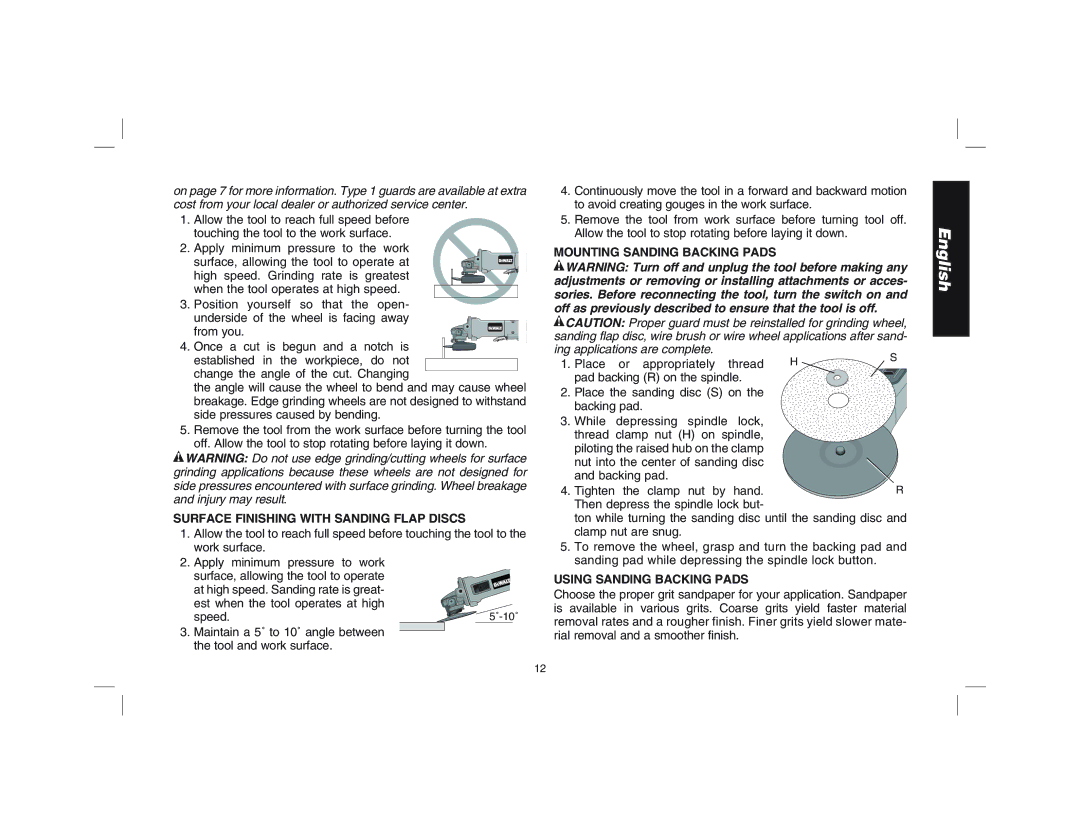
on page 7 for more information. Type 1 guards are available at extra cost from your local dealer or authorized service center.
1.Allow the tool to reach full speed before touching the tool to the work surface.
2. Apply minimum pressure to the work surface, allowing the tool to operate at high speed. Grinding rate is greatest when the tool operates at high speed.
3. Position yourself so that the open-
underside of the wheel is facing away from you.
4. Once a cut is begun and a notch is established in the workpiece, do not
change the angle of the cut. Changing
the angle will cause the wheel to bend and may cause wheel breakage. Edge grinding wheels are not designed to withstand side pressures caused by bending.
5.Remove the tool from the work surface before turning the tool off. Allow the tool to stop rotating before laying it down.
![]() WARNING: Do not use edge grinding/cutting wheels for surface grinding applications because these wheels are not designed for side pressures encountered with surface grinding. Wheel breakage and injury may result.
WARNING: Do not use edge grinding/cutting wheels for surface grinding applications because these wheels are not designed for side pressures encountered with surface grinding. Wheel breakage and injury may result.
SURFACE FINISHING WITH SANDING FLAP DISCS
1.Allow the tool to reach full speed before touching the tool to the work surface.
4.Continuously move the tool in a forward and backward motion to avoid creating gouges in the work surface.
5.Remove the tool from work surface before turning tool off. Allow the tool to stop rotating before laying it down.
MOUNTING SANDING BACKING PADS
![]() WARNING: Turn off and unplug the tool before making any adjustments or removing or installing attachments or acces- sories. Before reconnecting the tool, turn the switch on and off as previously described to ensure that the tool is off.
WARNING: Turn off and unplug the tool before making any adjustments or removing or installing attachments or acces- sories. Before reconnecting the tool, turn the switch on and off as previously described to ensure that the tool is off.
![]() CAUTION: Proper guard must be reinstalled for grinding wheel, sanding flap disc, wire brush or wire wheel applications after sand-
CAUTION: Proper guard must be reinstalled for grinding wheel, sanding flap disc, wire brush or wire wheel applications after sand-
ing applications are complete. | H | S | |
1. Place or appropriately thread | |||
|
pad backing (R) on the spindle.
2.Place the sanding disc (S) on the backing pad.
3.While depressing spindle lock, thread clamp nut (H) on spindle,
piloting the raised hub on the clamp |
|
nut into the center of sanding disc |
|
and backing pad. |
|
4. Tighten the clamp nut by hand. | R |
Then depress the spindle lock but-
ton while turning the sanding disc until the sanding disc and clamp nut are snug.
5. To remove the wheel, grasp and turn the backing pad and |
English
2.Apply minimum pressure to work surface, allowing the tool to operate at high speed. Sanding rate is great- est when the tool operates at high speed.
3.Maintain a 5˚ to 10˚ angle between the tool and work surface.
sanding pad while depressing the spindle lock button. |
USING SANDING BACKING PADS
Choose the proper grit sandpaper for your application. Sandpaper is available in various grits. Coarse grits yield faster material removal rates and a rougher finish. Finer grits yield slower mate- rial removal and a smoother finish.
12
